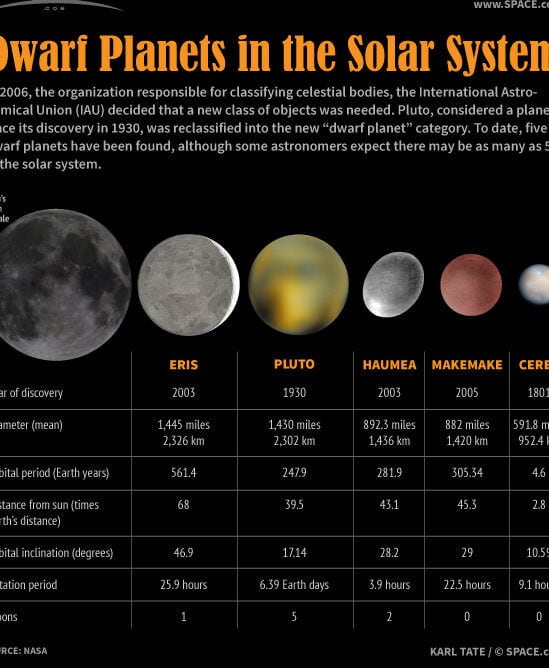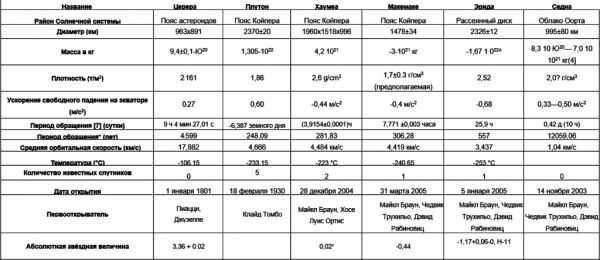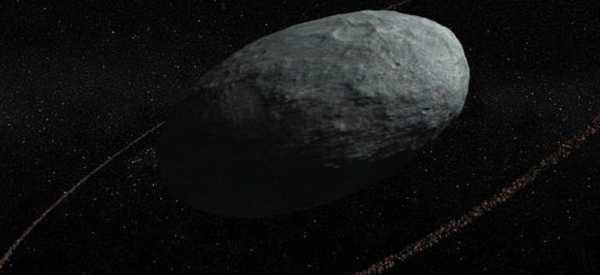
The Solar System
It is common knowledge that there are nine planets in the solar system, as we were taught in school. However, this belief changed in 2006 when scientists conducted a detailed study of Pluto and classified it as a dwarf planet due to the presence of various celestial bodies in its vicinity. Presently, astronomers are engaged in a lively debate about the number of dwarf planets in the solar system and their unique characteristics.
Most experts in the field of astronomy argue that there are six dwarf planets in total. These include Pluto, Ceres, Makemake, Erida, Haumea, and Sedna. Dwarf planets share common features, such as orbiting around the sun:
- orbit around the sun
- Almost circular shape is possible due to their weight
- They lack the ability to clear an orbital path
Scientific sources provide the most precise definition of dwarf planets. Astronomers’ recent studies indicate the existence of numerous dwarf planets in the solar system, yet to be found. Each of these planets is intriguing and expands our understanding of outer space.
Click on the picture to see a larger version
The Enigmatic Pluto
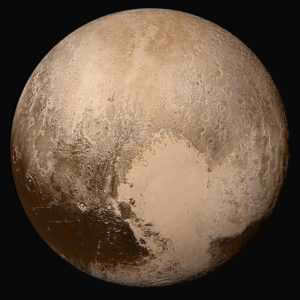
The furthest dwarf planet can be found in the Kuiper Belt. Its existence was initially suspected in the late 1800s. A dedicated search for this planet was carried out in the early 1900s by the renowned astronomer Percival Lowell. Despite extensive research, he was unable to locate the celestial body. His followers continued the search for this small planet, and it was not until the 1930s that Clyde Tombaugh finally discovered Pluto. The newly found object needed a name, and it was Venetia Burney, an Englishwoman, who suggested the name Pluto.
As these gases move away from the celestial body, they solidify and deposit on the surface. In contrast to Earth, a single rotation of Pluto takes 153 hours. The temperature on the planet is a frigid minus 223 degrees. It takes twenty years for Pluto to complete a single orbit around the Sun. The orbit of this celestial object has an elongated form and does not intersect with the orbit of its neighboring planet, Neptune. While Pluto completes two revolutions around the Sun, Neptune manages to complete three.
Ceres: the “small fry” in the asteroid belt
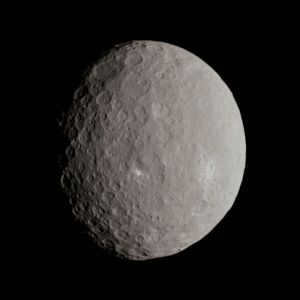

Ceres, the smallest and nearest dwarf planet to Earth among the known ones in the solar system, is called after the goddess of fertility. Unlike the other dwarf planets, it is not located in the Kuiper Belt but is found between Jupiter and Mars among the asteroids. It completes one orbit around the Sun in approximately five years. Ceres has a flattened spherical shape with a diameter of 950 kilometers. The images captured by the Hubble telescope reveal a surface covered in craters and mountains. Scientists propose that the object’s surface is composed of ice and there might be an ocean below. Additionally, they speculate the presence of carbonates and clay on the surface, creating a warm layer that could potentially support the origin of life.
Makemake: a planet made of methane
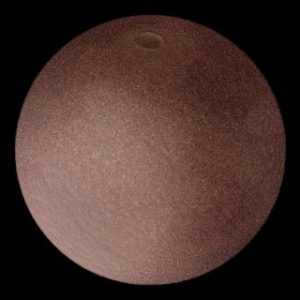
Makemake was discovered relatively recently – in the 5th year of the 21st century. This event took place a few days following Easter, and the astronomers searched for a fitting name for the planet. They settled on the god of abundance and the creator of the human race, who was revered by the people of Easter Island. The orbit of this planet is even more distant than that of Pluto. It takes three hundred and ten years for Makemake to complete one full revolution around the Sun. With a diameter of approximately 1500 kilometers, Makemake is considered the third largest dwarf planet. Upon studying the object, astronomers determined that the surface of the celestial body is composed of frozen methane and ethane, with a small amount of nitrogen present.
As the celestial body moves closer to the Sun, the methane and ethane particles undergo a transformation into a gaseous form. This celestial object shines the brightest among others in the Kuiper belt and can be observed using a regular amateur telescope. Upon observing the planet, scientists initially hypothesized the presence of an atmosphere, but upon analyzing the eclipse, it became evident that there is no gaseous envelope surrounding this celestial body. However, some scientists still hold the belief that an atmosphere may develop on the object as it nears Earth. Makemake is a solitary planet devoid of any natural satellites.
Erid, the planet without an atmosphere
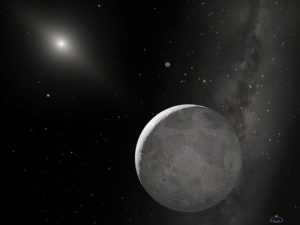
Haumea: the swiftest celestial body.
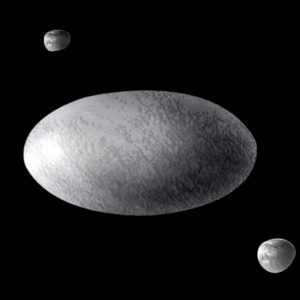
In 2004, scientists discovered the existence of a planet known as Haumea. Although this planet is nearly the same size as Pluto, it has a much smaller mass. This is due to the unique shape of Haumea, which resembles an American football. The planet rotates at a rapid pace, completing one full revolution every four hours. This fast rotation causes Haumea to become elongated in shape. Additionally, Haumea has two moons named Hiaka and Namaka. It takes Haumea approximately 283 years to orbit the sun. Recent research has revealed that the planet’s surface is covered in frozen water, similar to the ice found in a freezer. Scientists believe that this unique structure may be influenced by the gravitational forces of the moons or the presence of radioactive elements within Haumea.
Sedna: the farthest celestial body

It’s astonishing that Sedna is located 936 times further away from the Sun compared to our Earth. That’s a staggering distance of nearly 150 billion kilometers. Advanced ground-based and orbiting telescopes were utilized to detect this planet. While its status as a planet is still debated among scientists, they have been able to determine that its diameter is 1000 kilometers, making it larger than some of its celestial counterparts. Additionally, the discovery of organic matter within the ice on Sedna was another remarkable finding.
There is still a lack of consensus among scientists regarding the exact number of dwarf planets that have been identified within our solar system. However, each new discovery presents a valuable opportunity to further investigate and gain insights into our galaxy, ultimately helping us uncover the mysteries surrounding the origins of the planets within our universe.
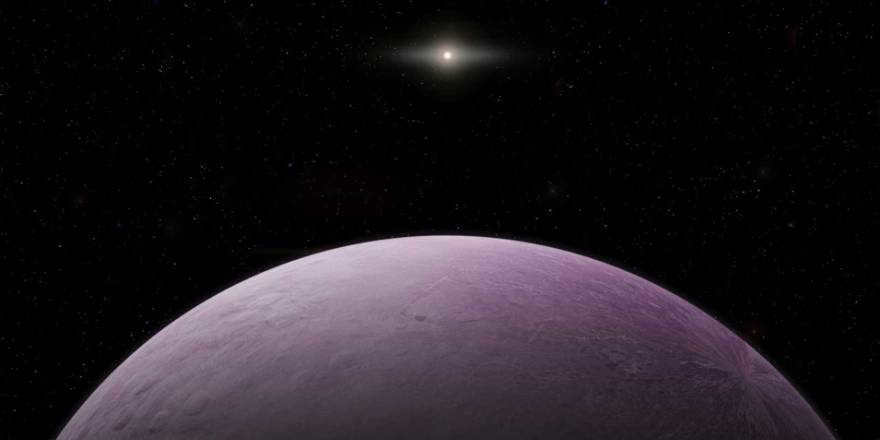
According to official records, there are currently five recognized dwarf planets in our solar system. However, there are an additional 40 candidates that are awaiting confirmation, as well as numerous potential undiscovered celestial bodies. But what exactly are these objects and where could they possibly be concealed?
An elevation in position
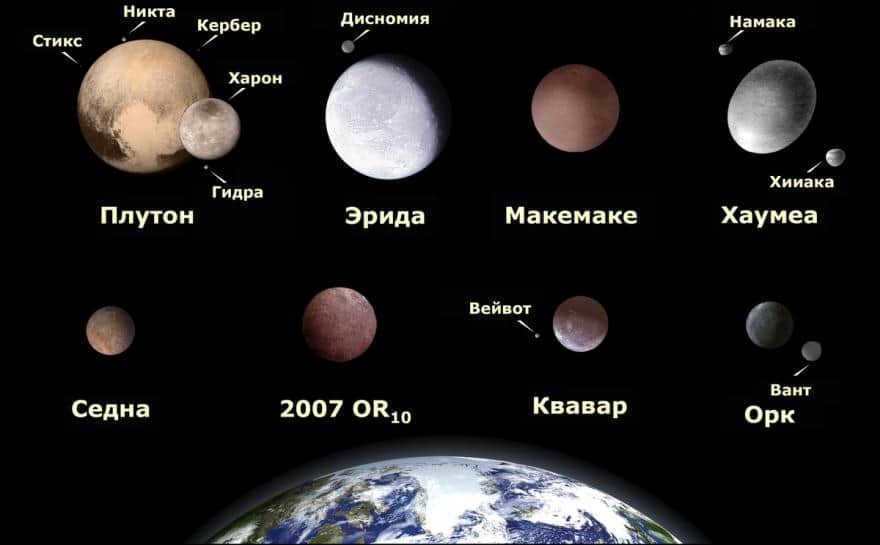
Comparative sizes of dwarf planets
While Pluto has faced difficulties and lost its planetary status, certain large cosmic bodies have gained recognition among astronomers. Officially, the term “dwarf planet” emerged in the scientific community in 2006.
The discovery of Erid sparked curiosity about the definition of a planet and introduced a new category of celestial bodies – the middle class. Dwarf planets fall between full-fledged planets and asteroids. They are no longer considered asteroids but do not meet the criteria for being classified as full planets.
Just like planets, the International Astronomical Union (IAU) has established criteria for dwarf planets:
- They orbit around the Sun.
- There is sufficient mass to form a spherical shape.
- There are still other objects in orbit (only planets are allowed to clear their orbital paths and dominate gravitationally in their vicinity).
Only 5 objects meet these criteria.
Ceres
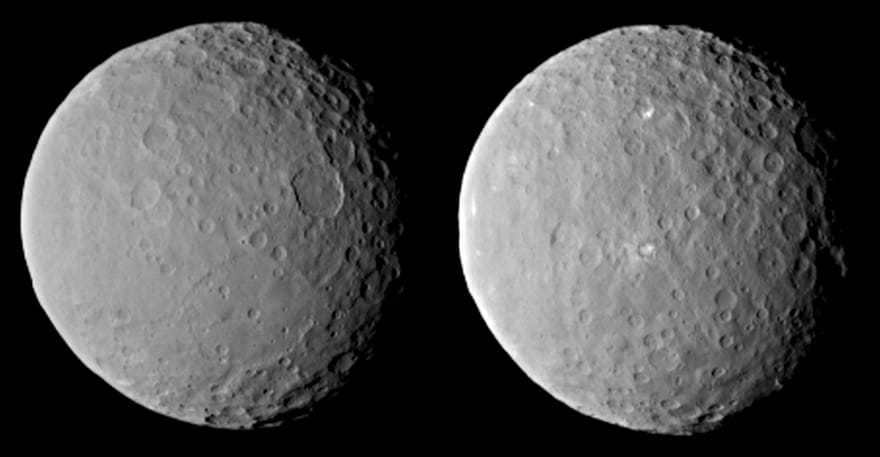
A photo taken by the spacecraft Dawn in 2015 shows a colorful view of the celestial body Ceres.
Ceres was first recorded in the year 1801 and was discovered relatively early due to its location in the asteroid belt. In 2015, the spacecraft Dawn visited Ceres. Initially, it was believed to be the first asteroid discovered, then it was considered a planet, and eventually it was classified as a dwarf planet.
Pluto
can be rephrased as follows:
The dwarf planet Pluto
.
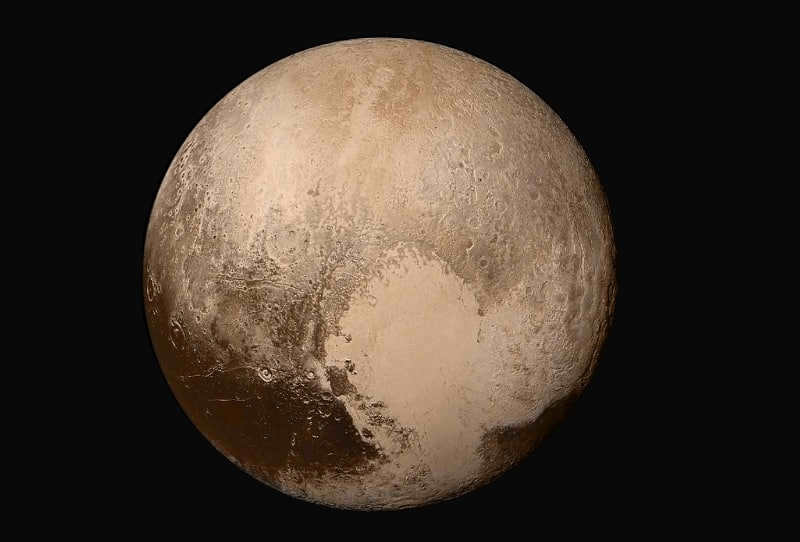
In 2015, the New Horizons mission captured a high-resolution image of Pluto, a former ninth planet that was demoted in 2006. This image reveals a remarkable trans-Neptunian object with five satellites. Additionally, the New Horizons spacecraft confirmed the presence of an atmosphere on Pluto.
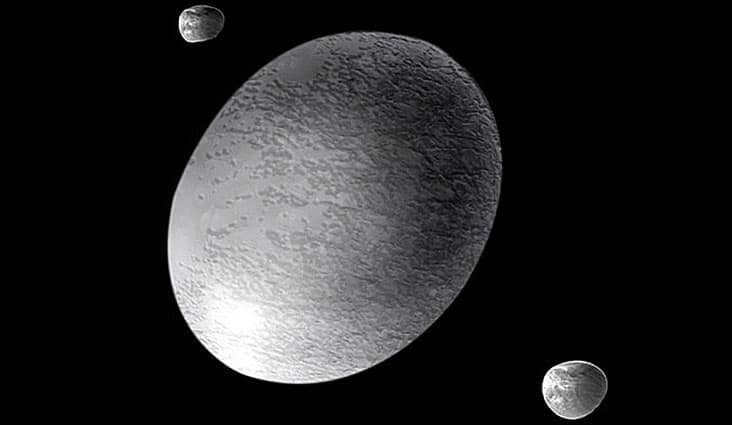
An artistic depiction of Haumea and its moons, Hiaka and Namaka
Haumea is a dwarf planet that rotates rapidly and has a highly elongated shape. It is believed that its elongated shape is a result of its fast rotation. The dwarf planet has two moons and there is a possibility that it also has a ring system. Scientists speculate that Haumea may have formed from the collision of two large fragments during the early stages of the solar system’s development.
Makemake
Makemake, originally designated as 2005 FY9, is a dwarf planet and a member of the Kuiper belt. It was discovered on March 31, 2005, by a team led by Mike Brown at the Palomar Observatory. Makemake is the third-largest known dwarf planet in the Solar System and one of the largest objects in the Kuiper belt. Its diameter is estimated to be about two-thirds that of Pluto. Like Pluto, Makemake is a plutoid, a type of dwarf planet that has a relatively large mass compared to its size. Makemake is named after the creation deity of the Rapa Nui people of Easter Island.
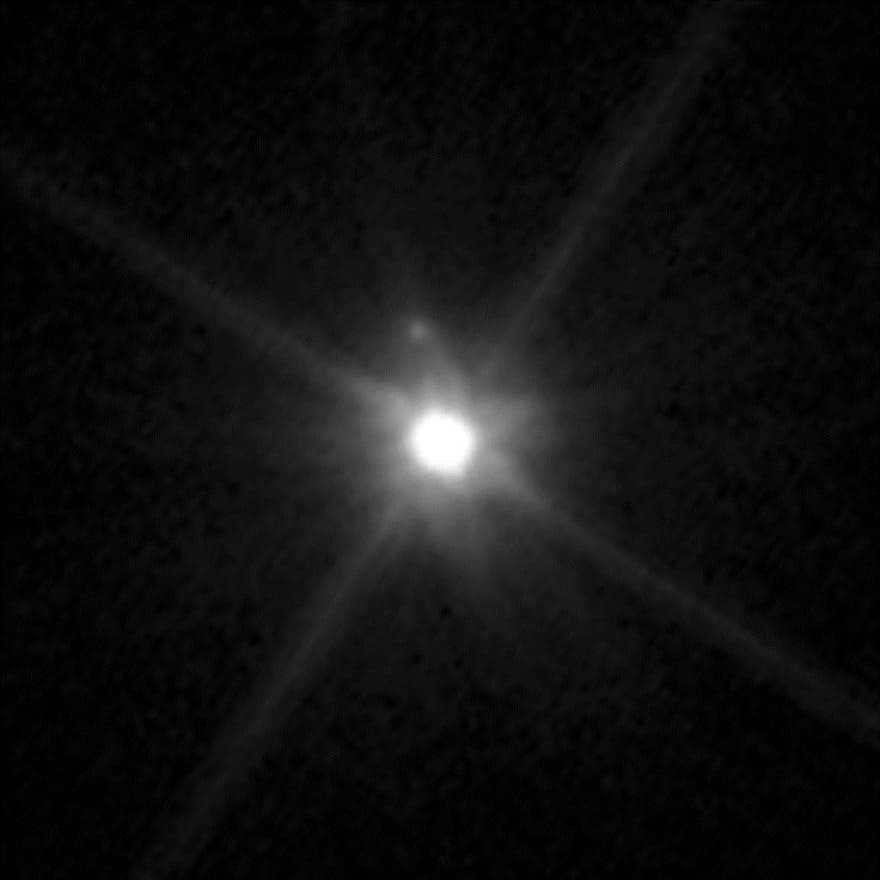

Makemake as captured by the Hubble telescope
One of the most significant celestial objects in the Kuiper belt, Makemake has a orbital period of 306 years, making it a fascinating subject for long-term observation. However, determining its exact mass and size remains a challenge. In fact, it was only in 2016 that a small satellite accompanying Makemake was discovered.
Erida.
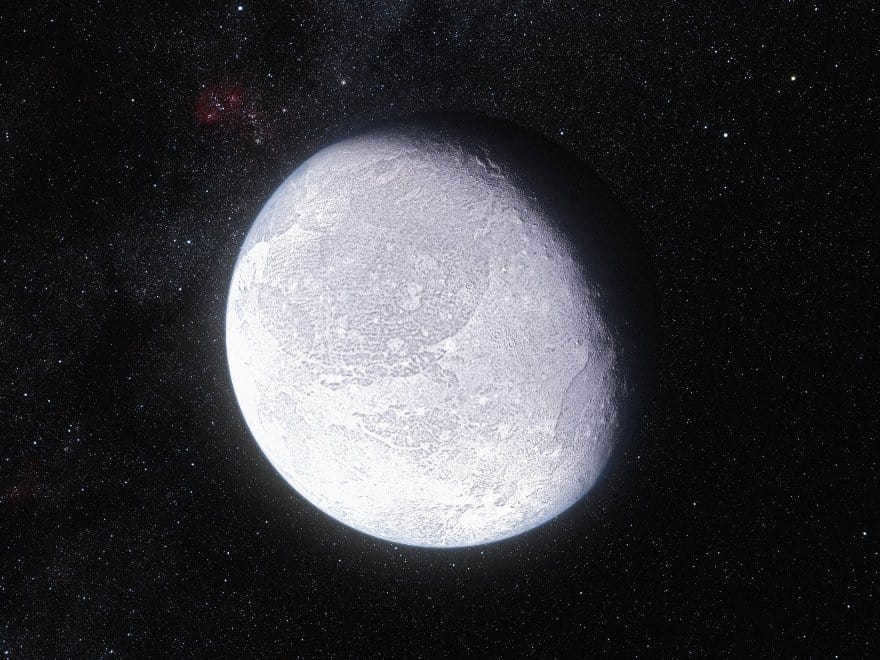
An artistic representation of Erida.
Ranked second in terms of size after Pluto, Erida is widely regarded as the most massive dwarf planet. Its existence has sparked a debate among astronomers regarding the planetary status of Pluto. It resides at a greater distance in the planetary lineup and was briefly referred to as Xenos.
Out of the five known celestial bodies, only Ceres is located relatively nearby. It can be found in the midst of the asteroid belt, which lies between Mars and Jupiter. The remaining four are much more challenging to reach as they reside in the outer solar system.
To locate them, one must search within the Kuiper belt or in its vicinity. It is important to remember that this vast region extends beyond Neptune’s orbit and is situated at a distance of 30 astronomical units (a.u.) from the star of the solar system, stretching all the way to 55 a.u. This expansive area presents a significant challenge for exploration. Somewhere within this region, there is still a planet X.
What is the potential number of dwarf planets in existence?
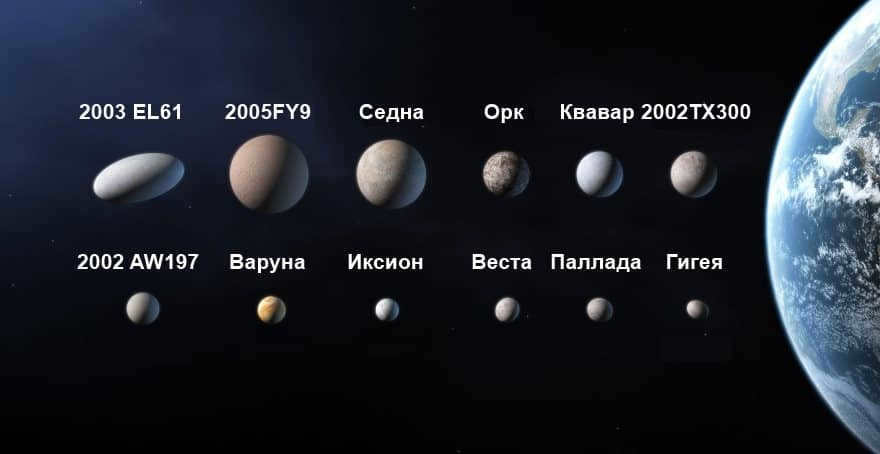
Comparative sizes of potential dwarf planets
There are approximately 40 to 45 potential candidates. The person who discovered Erida, Michael Brown, believes that he can identify even more, up to 400 objects. Other scientists have proposed investigating around two hundred within the Kuiper belt and potentially discovering up to 10,000 dwarf contenders beyond that boundary.
P.S.
The issue lies in the fact that dwarf planets possess diminutive dimensions. Given their considerable distance, accurately determining their precise characteristics would prove to be an immensely challenging task, consequently leading to potential complications in classification.

In addition to the eight major planets, there exist numerous dwarf planets and an immeasurable quantity of various small objects within our solar system. These are the subjects that we will delve into further in this instructional video.
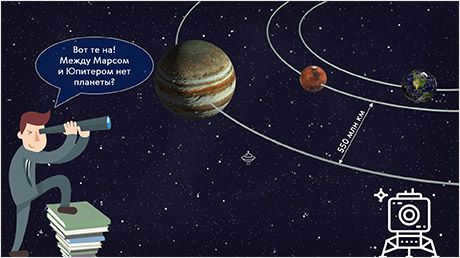
Unfortunately, at the moment, you are unable to view or distribute the instructional video to your students
In order to gain access to this and other video lessons included in the package, you will need to add it to your personal account.
Unlock extraordinary possibilities


Lesson Outline: Dwarf Planets and Small Bodies in the Solar System
Before August 2006, the solar system consisted of nine large planets, including Pluto, which was discovered by Clyde Tombaugh in 1930. However, Pluto had distinct characteristics that set it apart from the other planets. In 1978, it was revealed that Pluto had a satellite called Charon, which was only two times smaller in diameter compared to Pluto. Additionally, their mass ratio was 1 to 8.
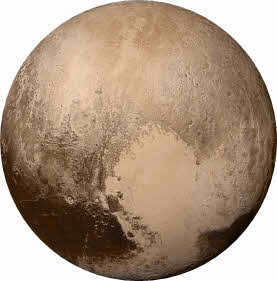
It was later revealed that Pluto, along with its companion, is just one of many large objects in the Kuiper Belt. In fact, there is at least one object in the belt, Erida, that is slightly smaller in size.
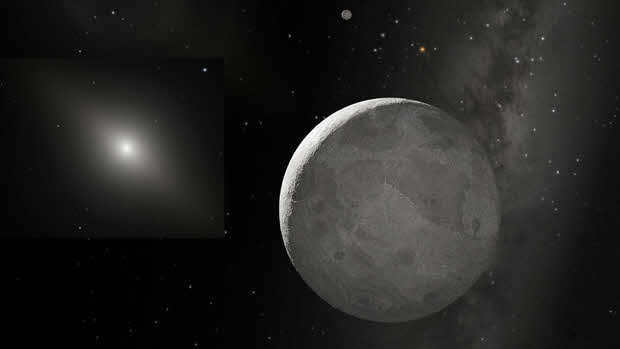
As a result of the decision made at the International Astronomical Union Assembly in August 2006, Pluto was classified as a dwarf planet, joining a new category of objects in the solar system. Dwarf planets.
Currently, there are officially recognized five dwarf planets by the International Astronomical Union: the former asteroid Ceres and four transneptunian objects (which are bodies orbiting the Sun beyond Neptune’s orbit): Pluto proper, Haumea, Makemake, and Erida. One other strong candidate for the dwarf planet status is Sedna.
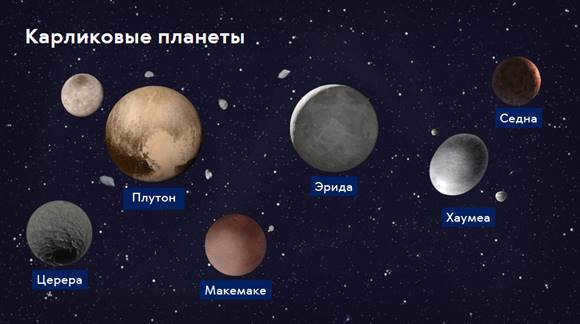
All objects that are not satellites and orbit the Sun, except for dwarf planets, are referred to as small bodies of the solar system.
The discovery of Ceres, a former asteroid turned dwarf planet, in the 18th century was truly remarkable. We are all familiar with Aristotle’s famous saying: “nature abhorrates vacuum, i.e. nature does not tolerate emptiness”, which was widely accepted as truth by the scientific community for a long time. It is not hard to imagine the astonishment of astronomers when they discovered a vast empty region stretching for 550 million kilometers between the orbits of Mars and Jupiter, while the distance between the orbits of other planets was no more than 80 million kilometers. Johannes Kepler proposed that there must be a planet in this gap. In 1766, an unknown astronomer named Johann Titius derived a formula that allowed the calculation of average distances from planets to the Sun in astronomical units.
In his formula, the variable п represents a number that can have different values depending on the planet. For example, for Mercury, it takes the value of minus infinity, for Venus it is zero, and for Earth it is one. This pattern continues for other planets as well.
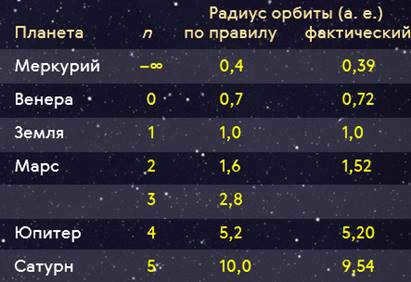
Therefore, situated at a distance of 2.8 astronomical units from the Sun, precisely between the orbits of Mars and Jupiter, there exists no planet. Johann Bode made the prediction that a planet should exist at this particular distance and even calculated its orbital period around the Sun – 4.5 years.
Furthermore, when Uranus was discovered by Herschel in March 1781, its distance closely matched the calculated formula. This left no doubt that the Titius-Bode rule reflects certain patterns in the composition of our solar system.
On the first day of the year 1801, while the majority of people on our planet were celebrating the arrival of the new year, an incredible event was taking place in the heavens. The talented Italian astronomer, Giuseppe Piazzi, made an astounding discovery – a tiny planet in the vast expanse of the sky. What made this finding even more fascinating was its placement, as it occupied the exact space that had been missing between the orbits of Mars and Jupiter. In honor of the ancient Roman goddess associated with fertility, the newly found celestial body was given the name Ceres.
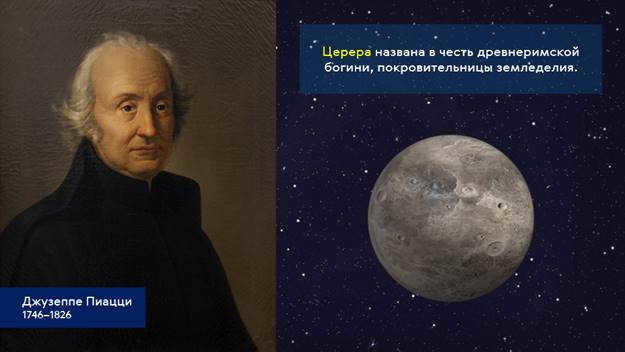
On March 28, a German astronomer named Heinrich Olbers made an interesting observation. While studying the movement of Ceres, he stumbled upon a previously unknown star that was moving in a similar orbit. This star turned out to be a small planet, which was later named Pallada.
Olbers’ discovery led him to speculate that there might be more small planets between Mars and Jupiter. His suspicions were confirmed on September 1, 1804, when Carl Harding discovered another small planet called Juno. Then, on March 29, 1807, Olbers himself made another significant discovery – a fourth minor planet named Vesta.
It is now confirmed that the region between the orbits of Mars and Jupiter in the solar system is a collection of numerous objects of varying shapes and sizes, known as asteroids or minor planets. This particular region is commonly known as the main asteroid belt, highlighting its uniqueness compared to other small planet cluster areas like the Kuiper belt found beyond Neptune’s orbit and the group of objects in the diffuse disk and the Oort cloud.
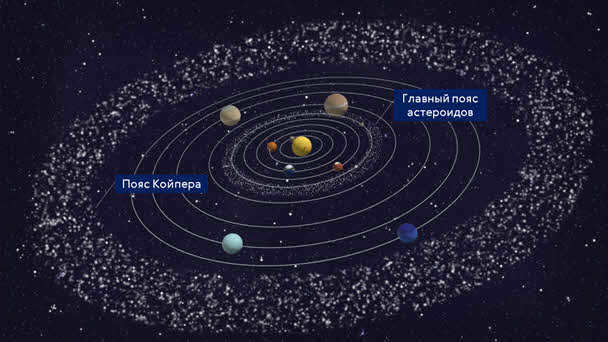
Moreover, there exist several fascinating anomalies. For instance, Jupiter’s orbit harbors two prominent clusters of asteroids, which have been dubbed Trojans in homage to the characters from the Trojan War. The initial group is named after Greek heroes and is referred to as the Achaean Camp (also known as the Greeks). The second group, on the other hand, is named after the defenders of Troy and constitutes the Trojan Camp (or simply the Trojans). Presently, “Trojans” have been discovered near Earth, Mars, Uranus, and Neptune.
The Galileo spacecraft holds the distinction of being the first to capture images of asteroid surfaces. During its journey to Jupiter, it managed to photograph Gaspra and Ida, along with its accompanying satellite Dactyl.
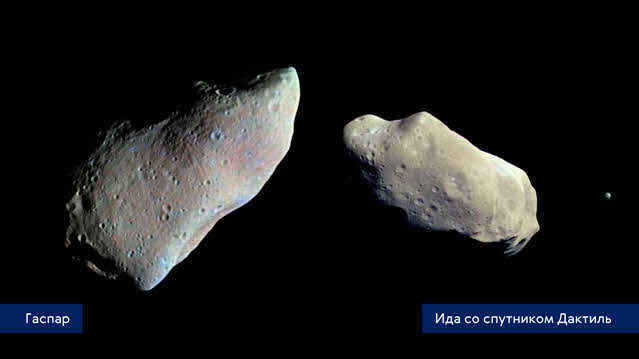
The first successful landing on the asteroid Eros took place on February 12, 2001, when the spacecraft “NEAR Shoemaker” touched down gently on its surface.
In the vast expanse of interplanetary space, there are numerous stone and iron bodies of varying sizes, shapes, and compositions. These bodies are known as meteorites. Many of them are the result of asteroid collisions and subsequent fragmentation. When such a body enters Earth’s atmosphere at high velocity, the friction with the air causes it to heat up, melt, and emit a glowing light. This phenomenon is known as a bolide, and particularly bright ones are sometimes referred to as super bolides.
Some of the most notable bolides in recent history include:
The Vitimsky bolide was observed in the northeastern part of the Irkutsk region on the night of September 24-25, 2002. Another bolide flew over Bashkiria on February 11, 2013. On February 15, 2013, a meteor body exploded in the atmosphere near Chelyabinsk. It is estimated that the initial mass of the bolide was about 10,000 tons and it had a size of 17 meters. Additionally, there was a bright bolide that exploded in the sky over the Crimea on November 21, 2013.
Objects that manage to reach the surface of the Earth are known as meteorites. While most meteorites are fragments of asteroids, there are also rare cases where they originate from the Moon or Mars.
It is extremely uncommon for our planet to experience the descent of exceptionally large meteorites, which typically have an initial mass ranging from several tens to hundreds of tons. When these meteorite bodies collide with the Earth, they cause a tremendous explosion, creating a crater at the point of impact. One of the most renowned meteorite craters is located in Arizona, USA. This particular crater boasts a diameter of 1200 meters, a depth of 180 meters, and a shaft height of approximately 50 meters.
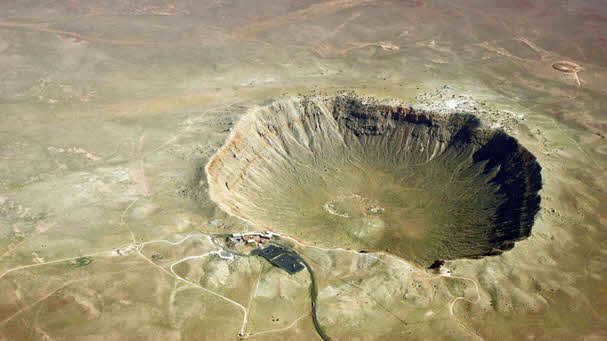
The approximate age of the crater is around 30 thousand years. In general, it is quite challenging to detect large craters on Earth as they tend to erode relatively quickly due to the effects of air, water, and wind.
Based on their composition, meteorites can be classified into three groups. The first group consists of stone meteorites, known as chondrites, which contain mineral-rich spheres called chondrites. The second group, which is relatively small, is made up of iron-stone meteorites that are composed of approximately 50% iron and 50% stone.
The third group comprises iron meteorites.
The largest meteorite ever discovered is the Goba iron meteorite, which was found in Namibia in 1920.
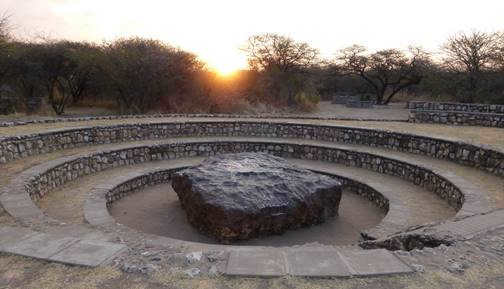
It is believed that the meteorite fell approximately 80,000 years ago. Scientists estimate that when it crashed into the Earth, its original mass was around 90 tons. However, due to acts of vandalism, erosion, and scientific research, the meteorite has “lost weight” and now weighs approximately 60 tons.
Additionally, comets are among the small bodies in our solar system. Comets are delicate entities consisting of loosely bound clumps of frozen gas and dust that follow highly elongated elliptical orbits around the Sun.
The term “comet” in Greek translates to “hairy star.” In ancient Greece and later in the Middle Ages, comets were often depicted as severed heads soaring across the sky with their hair flowing.
Comets have long captivated people’s attention due to their distinctive appearance. The earliest Chinese records mentioning comets date back to the third millennium BC.
Throughout human history, tragic events such as wars, epidemics, and palace coups have always been abundant. Interestingly, these events have often coincided with the appearance of a bright comet. For instance, ancient Roman historians noted that the death of Caesar occurred simultaneously with the sighting of a brilliant comet in the sky. Consequently, during the Middle Ages and even later, it was commonly believed at royal courts that comets were harbingers of the king’s or his heir’s demise. This belief conveniently attributed palace intrigue to the natural phenomenon of comets.
However, ancient China held a different perspective on comets. They believed that comets served as messengers for the Sun, delivering decrees to distant provinces where the bright planets held sway as rulers.
However, we have deviated slightly from the main topic. When a comet is far away from the Sun, it appears as a dim and hazy object. Nevertheless, as it gets closer to the star, it becomes more luminous and expands in size.
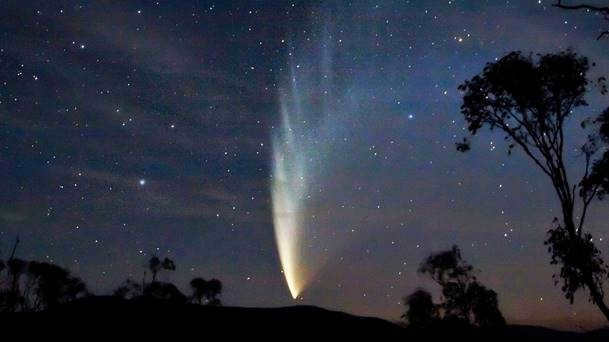
The reason for this phenomenon is that the core of the comet is composed of 80% water ice, as well as frozen carbon dioxide, methane, ammonia, and other substances. As the comet gets closer to the Sun, its core heats up and releases gases and dust through vaporization, creating the comet’s head. The dust and gas then leave the comet’s core through emissions formed on the side facing the Sun and are usually carried away in the opposite direction from the Sun, forming the comet’s tail. In many cases, the tails of bright comets can stretch for hundreds of millions of kilometers. For instance, the tail of comet Hyakutake reached a length of nearly 300 million kilometers.
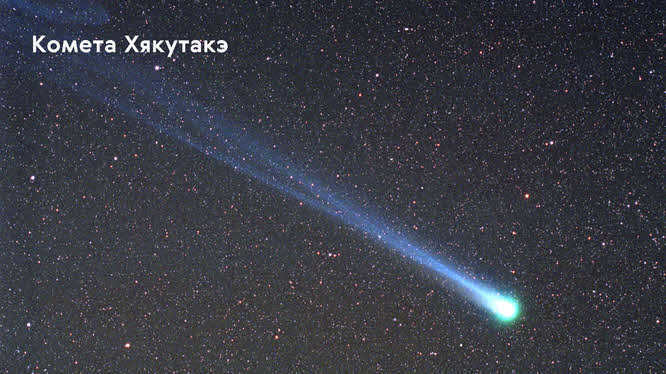
Comet tails can be categorized into different types based on their shape:
The first type is characterized by a tail that forms due to the acceleration of cometary ions by the solar wind, which is directed away from the Sun.
The second type is a slightly curved tail composed of dust particles that range in size from tiny fractions to tens of micrometers.
The third type consists of larger dust particles and is typically strongly curved due to the influence of a magnetic field.
The fourth type is known as the “Antitail” and occurs when ejections from the comet’s head are directed towards the Sun.
In addition, comets are generally classified as either short-periodic (with an orbital period of less than 200 years) or long-periodic.
Edmund Halley, an astronomer, made an incredible discovery when he noticed the striking resemblance of the orbits of three comets – one from 1531, another from 1607, and the last from 1682. He proposed the theory that these comets were actually the same one, making successive returns to our solar system. Halley went on to predict that this comet would reappear in 1758, a staggering 76 years later. As a result of his groundbreaking work, this particular comet became known as Halley’s Comet.
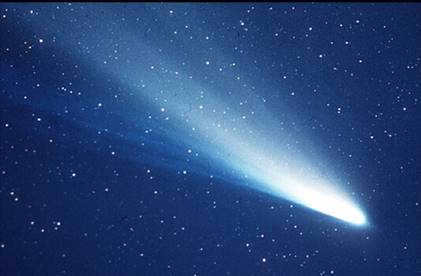
Comets were exclusively observed through telescopes for an extended period of time. However, on March 2, 2004, the Rosetta spacecraft was launched with the sole purpose of investigating the Churyumov-Gerasimenko comet. Eventually, in the summer of 2014, Rosetta successfully reached its destination and became the inaugural spacecraft to enter orbit around the comet. Later, on November 12 of that year, the Philae research vehicle was deployed to the surface of the comet to conduct an in-depth analysis of its composition and structure.
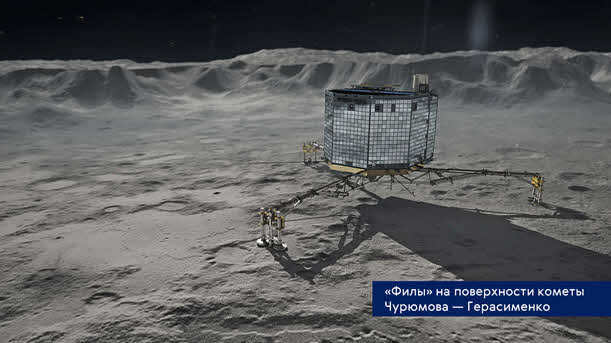
Every time a comet returns to the Sun, it leaves a lasting impact. Typically, the nucleus of a comet loses approximately 1/1000 of its mass and eventually perishes. There is even the possibility of collisions with planetary surfaces or meteoric bodies. As comets break apart, they create trails of dust that extend along their orbits. Occasionally, these trails intersect with the Earth’s orbit. When the dust particles enter the Earth’s atmosphere, they burn up and produce a luminous streak. This phenomenon is known as a meteor, and the particle itself is referred to as a meteor or meteoroid. It is estimated that around 50 thousand tons of meteoric matter enter the Earth’s atmosphere each year.
Occasionally, meteors appear to emerge from a specific area of the sky. This particular area is known as a radiant point.
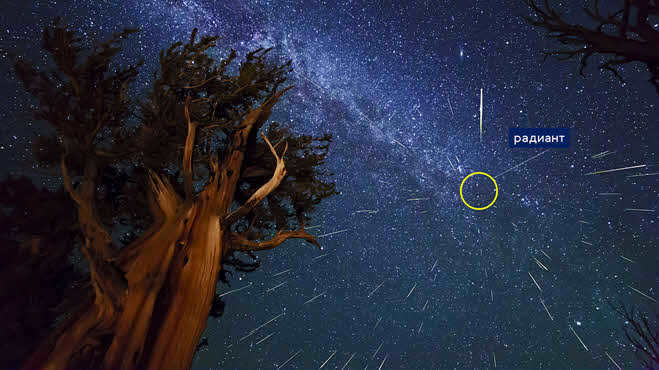
Many times, the celestial event known as a meteor shower receives its name based on the constellation or star that is in close proximity to its radiant point.

Size, albedo, and color are compared among the dwarf planets Pluto, Haumea, Makemake, Erida, and other significant transneptunian objects. Additionally, their respective satellites are depicted.
A dwarf planet, as defined by the International Astronomical Union, is a celestial body that orbits the Sun, has enough mass to maintain hydrostatic equilibrium under the force of gravity, and has a nearly spherical shape. It is not a satellite of a planet and cannot clear its orbital region of other objects. The term “dwarf planet” was introduced in 2006 as part of the classification of celestial bodies in our solar system. Bodies that are large enough to clear their orbital path are classified as planets, while those that are not large enough to reach hydrostatic equilibrium are considered small solar system bodies or asteroids. Dwarf planets occupy a middle position between these two categories. This definition has received both approval and criticism and is still debated by some scientists. Some propose a simpler division between planets and dwarf planets based on the size of Mercury or even the Moon: if larger, then it’s a planet, if smaller, then it’s a planetoid. The International Astronomical Union officially recognizes 5 dwarf planets: the largest asteroid Ceres and the trans-Neptunian objects Pluto, Erida, Makemake, Haumea. However, it is possible that at least 40 more known objects in our solar system belong to this category. According to various estimates, there may be as many as 200 dwarf planets in the Kuiper belt and up to 2000 dwarf planets beyond it. The classification of dwarf planet-like bodies in other planetary systems has not yet been determined.
Ceres – asteroid belt – no satellites
Pluto – Kuiper belt – 5 satellites (Charon, Hydra, Nycta, Styx, Kerber)
Erida – scattered disk – 1 satellite (Dysnomia)
Makemake – Kuiper belt – no satellites
Haumea – Kuiper belt – 2 satellites (Hiiaka, Namaka)
In 2006, the International Astronomical Union (IAU) gave official names to three celestial bodies that were immediately categorized as dwarf planets – Pluto, which was previously classified as a planet and is known as the largest transneptunian object, Erida, and Ceres, which is the largest asteroid. Later on, two more transneptunian objects were designated as dwarf planets. It is important to note that the term “dwarf planet” should be differentiated from the term “minor planet”, which traditionally refers to asteroids.
| 1 | 134340 | 136108 | 136472 | 136199 | 90377 |
| Asteroid Belt | Kuiper Belt | Scattered disk | Oort Cloud | ||
| 963×891 | 2370±20 | 1960×1518×996 | 1478±34 | 2326±12 | 995±80 km |
| 9,4±0,1·10 20 | 1,305·10 22 | 4,2·10 21 | ~3-10 21 kg | ~1,67·10 22 | 8.3-1020-7.0-1021 kg |
| 0,0738 471 | 0,180 1148,07 | ~750 | 0,19 ~1300 | ||
| 0,0032 | 0,053 | 0,013 | 0,068 | ||
| 2,161 | 1,86 | 2.6 g/cm³ | 1.7±0.3 g/cm³ | 2,52 | 2.0? g/cm³ |
| 0,27 | 0,60 | ~0.44 m/s² | ~0.4 m/s² | ~0,68 | 0.33-0.50 m/s² |
| 0,51 | 1,2 | ||||
| 0,3781 | -6.38718 (retrograde) | 102937 d (281.83 a) | 111867 days (306.28 a) | 203,830 days (558.04 years) | approximately 4,404,480d (12,059.06 a) |
| 2,5—2,9 2,766 413 715 000 | 29,66—49,30 39,48168677 5 906 376 200 | 37,77—97,56 67,6681 10 210 000 000 | 541.429506 a. e. | ||
| 4,599 | 248,09 | 281,83 | 306,28 | 557 | 12059,06 |
| 17,882 | 4,666 | 4.484 km/s | 4.419 km/s | 3,437 | 1.04 km/s |
| 0,080 | 0,24880766 | 0,1975233 | 0,16254481 | 0,44177 | 0,8590486 |
| 10,587° | 17,14175° | 28,201975° | 29,011819 ° | 44,187° | 11,927945° |
| 4° | 119,61° | ||||
| 167 | 40 | 50 К | 30-35 K (based on albedo) | 30 | |
| 0 | 5 | 2 | 1 | 0 | |
| January 1, 1801 | February 18, 1930 | December 28, 2004 | March 31, 2005 | January 5, 2005 | November 14, 2003 |
* Value compared to Earth. Out of all the celestial bodies on this list, only Pluto has undergone a change in status, being demoted from a planet to a dwarf planet. Meanwhile, the other bodies on the list have been promoted from being mere asteroids to something more significant.
Other contenders
There are already several dozen celestial bodies that could potentially be classified as dwarf planets. The classification of Charon, which is currently considered a moon of Pluto, remains uncertain due to the lack of a precise definition that distinguishes between satellite planets and double planetary systems. The preliminary resolution released by the International Astronomical Union (IAU) suggests that Charon could be considered a planet because it meets the size and shape requirements for planet status, according to the latest resolution for dwarf planet status.
| Kubiwano in the Kuiper Belt | 400-800 km | unknown |
| Scattered disk object | ~1535 km | unknown |
| Kyubivano in the Kuiper belt | 1074-1170 km | 1.0-2.6-10 21 kg |
| Kubiwano in the Kuiper Belt | ~934 km | unknown |
| Plutino in the Kuiper belt | 917-946 km | 6.2-7.0-10 20 kg |
| Kyubiwano in the Kuiper belt | ~921 km | 4,5×10^20 |
| Scattered disk object | ~733 km | unknown |
| Kyubiwano in the Kuiper belt | 722 km | ~5.9×10^20 kg |
| Kyubiwano in the Kuiper Belt | 681-910 km | ~7.9×10^20 kg |
| Plutino in the Kuiper Belt | ~650 km | 5,8×10^20 |
| Qubiwano in the Kuiper Belt | 626-850 km | ~4.1×10^20 kg |
| Kyubiwano in the Kuiper Belt | 550-1240 km | unknown |
| Ciubivano in the Kuiper Belt | 500-1130 km | ~6.1×10^20 kg |
| Ciubivano in the Kuiper Belt | ~730 km | unknown |
| Plutino in the Kuiper Belt | ~725 km | unknown |
| Unknown (Kuiper belt) | 609-730 km | unknown |
| Kyubiwano in the Kuiper Belt | ~677 km | unknown |
| Scattered disk object | 590-1145 km | 1.5×10^21 |
| Plutino in the Kuiper Belt | 573-727 km | unknown |
| Kyubiwano in the Kuiper Belt | 420-940 km | unknown |
| Kyubiwano in the Kuiper Belt | 380-860 km | unknown |
| Kyubiwano in the Kuiper Belt | ~613 km | unknown |
| Kyubiwano in the Kuiper Belt | ~600 km | unknown |
| Scattered disk object | ~600 km | unknown |
| Kyubivano in the Kuiper belt | ~591 km | unknown |
| Scattered disk object | 460-1030 km | unknown |
| Scattered disk object | 470-1000 km | unknown |
| Scattered disk object | 440-980 km | unknown |
| Scattered disk object | ~636 km | unknown |
| Scattered disk object | ~598 km | unknown |
| Scattered disk object | ~595 km | unknown |
| Scattered disk object | ~595 km | unknown |
| Scattered disk object | ~583 km | unknown |
| Scattered disk object | ~580 km | unknown |
| Scattered disk object | ~575 km | 2×10^20 |
| Scattered disk object | 425-850 km | 0.6—4.8×10^20 |
| Kubiwano in the Kuiper Belt | 423-580 km | unknown |
| Kyubiwano in the Kuiper Belt | 340-770 km | unknown |
| Scattered disk object | 565-584 km | unknown |
| Kubiwano in the Kuiper belt | ~554 km | unknown |
| Plutino in the Kuiper Belt | ~549 km | unknown |
- Charon meets the size and shape requirements to be classified as a dwarf planet.
- Due to its larger mass compared to Pluto, Charon orbits around a common center of mass located in space between the two bodies, rather than orbiting a point within Pluto.
However, this specific definition is not part of the final decision made by the IAU. It is also unclear if it will be included in future decisions. If this definition is approved, Charon would be classified as a dwarf (double) planet. To expedite the resolution of this issue, the inclusion of tidal interception or synchronous rotation of both components of the binary system is currently under discussion as an additional criterion.
Dimensions and weight of small planets
The International Astronomical Union (IAU) does not provide specific criteria for the size and mass of small planets. There are no strict boundaries for the upper limits, which means that any object larger or more massive than Mercury with a clear orbital neighborhood can be categorized as a small planet.
The lower limit is determined by the concept of hydrostatic equilibrium, but the exact dimensions and weight of an object that has achieved this state are uncertain. Based on empirical observations, it is believed that these values can vary significantly depending on the object’s composition and history. The initial IAU decision, which defined hydrostatic equilibrium, applied to objects with masses greater than 5-1020 kg and diameters greater than 800 km, but this specific criteria was not included in the final decision that was ultimately approved.

